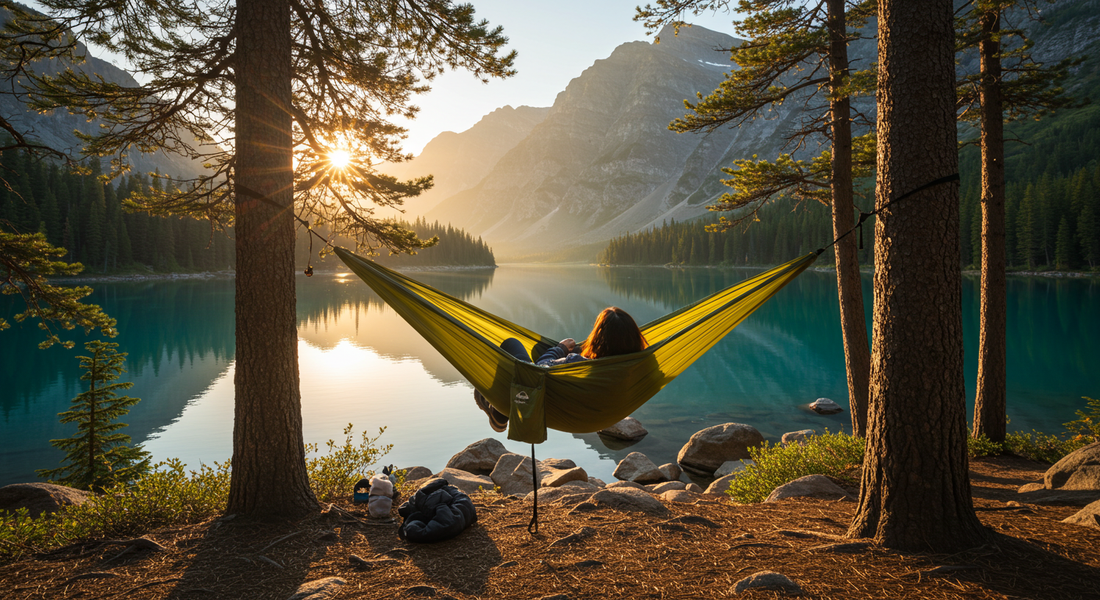
The Complete Guide to Hammocks – Relax in Comfort with Packstead
Share
Why Hammocks Are a Camping Game-Changer
There’s something timeless about resting in a hammock. Whether it’s strung between two pine trees in the mountains or hung by the beach with the sound of waves in the background, hammocks offer a level of relaxation that chairs and sleeping pads can’t match. For campers, backpackers, and even backyard loungers, a good hammock can double as a place to rest, sleep, and take in the beauty of nature.
In this guide, we’ll explore the different types of hammocks, what to consider before buying, setup tips, and examples of hammock categories you can find at Packstead.
1. Main Types of Hammocks
1.1 Camping Hammocks
-
Features: Lightweight, compact, and designed for portability.
-
Best for: Backpackers and minimalist campers.
-
Typical Add-ons: Mosquito net, rain fly, and suspension straps.
1.2 Spreader Bar Hammocks
-
Features: Wooden or metal bars at each end to keep the hammock fabric spread out.
-
Best for: Backyard relaxation and beach lounging.
-
Pros & Cons: More open and flat surface, but less stable in windy conditions.
1.3 Double Hammocks
-
Features: Extra width for two people or for solo campers who want more room.
-
Best for: Couples camping or people who like extra space to sprawl.
1.4 Ultralight Hammocks
-
Features: Made from high-strength, lightweight materials like ripstop nylon.
-
Best for: Thru-hikers and long-distance trekkers where every gram counts.
1.5 Hammock Chairs
-
Features: Seated design with overhead suspension.
-
Best for: Campsites, porches, and patios where you want upright relaxation.
2. Hammock Materials & Durability
-
Nylon (Ripstop or Parachute) – Lightweight, quick-drying, and durable.
-
Polyester – UV-resistant and great for long-term outdoor use.
-
Cotton – Soft and breathable, but heavier and slower to dry.
When choosing materials, consider weather resistance, weight capacity, and comfort.
3. Key Factors to Consider When Buying a Hammock
-
Weight Capacity – Most hammocks range from 200 to 500 lbs. Always choose a capacity that exceeds your expected load.
-
Packed Size – For backpacking, choose models that compress into small stuff sacks.
-
Suspension System – Look for tree-friendly straps that won’t damage bark.
-
Weather Protection – For camping, consider rain flies and bug nets.
-
Setup Time – Quick-clip carabiners and adjustable straps save time at camp.
4. Hammock Setup Tips for Comfort & Safety
-
Hang your hammock at a 30-degree angle from the anchor points.
-
Keep the hammock height around 18 inches off the ground.
-
Use tree straps at least 1 inch wide to protect trees.
-
Avoid hanging over rocks, sharp objects, or steep slopes.
-
If sleeping overnight, pair with an underquilt or sleeping pad for insulation.
5. Example Hammock Categories at Packstead
-
Lightweight Camping Hammocks – Compact and portable for hiking trips.
-
Double Hammocks – Spacious designs for couples or solo comfort.
-
Hammocks with Bug Nets – Built-in mosquito protection for summer camping.
-
All-Weather Hammocks – Designed with rain flies and thermal insulation for 4-season use.
(These are general product categories for informational purposes, not specific models.)
6. Accessories to Pair with Your Hammock
-
Tree-Friendly Suspension Straps – Adjustable and bark-safe.
-
Underquilts & Topquilts – For warmth during cold nights.
-
Rain Flies & Tarps – Protection against rain and wind.
-
Gear Lofts & Ridgelines – Extra storage for small items.
Conclusion
A hammock can be much more than a casual lounge spot — it can be your bed, your reading chair, or your escape into nature. By choosing the right hammock type, material, and accessories, you can transform your camping or backyard experience into something far more relaxing and enjoyable. Packstead offers a variety of hammock categories designed to fit different needs, from ultralight backpacking to cozy two-person setups.


